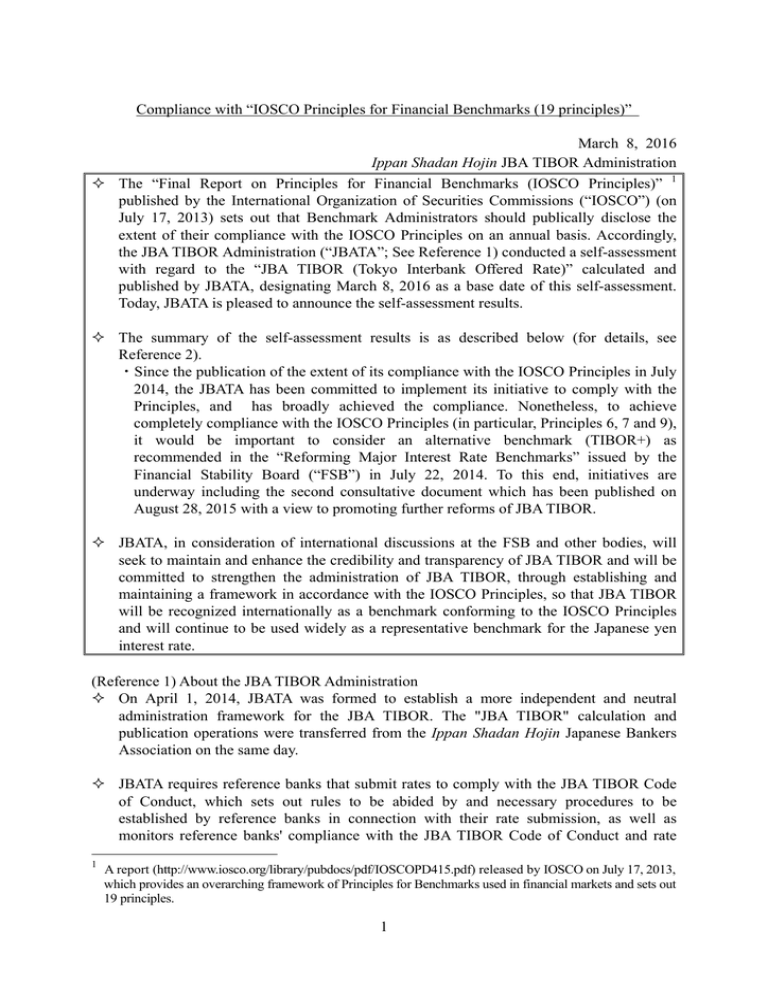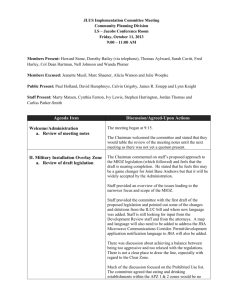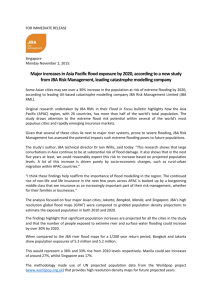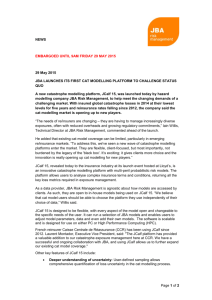1 Compliance with “IOSCO Principles for Financial Benchmarks (19
advertisement

Compliance with “IOSCO Principles for Financial Benchmarks (19 principles)” March 8, 2016 Ippan Shadan Hojin JBA TIBOR Administration The “Final Report on Principles for Financial Benchmarks (IOSCO Principles)” 1 published by the International Organization of Securities Commissions (“IOSCO”) (on July 17, 2013) sets out that Benchmark Administrators should publically disclose the extent of their compliance with the IOSCO Principles on an annual basis. Accordingly, the JBA TIBOR Administration (“JBATA”; See Reference 1) conducted a self-assessment with regard to the “JBA TIBOR (Tokyo Interbank Offered Rate)” calculated and published by JBATA, designating March 8, 2016 as a base date of this self-assessment. Today, JBATA is pleased to announce the self-assessment results. The summary of the self-assessment results is as described below (for details, see Reference 2). ・Since the publication of the extent of its compliance with the IOSCO Principles in July 2014, the JBATA has been committed to implement its initiative to comply with the Principles, and has broadly achieved the compliance. Nonetheless, to achieve completely compliance with the IOSCO Principles (in particular, Principles 6, 7 and 9), it would be important to consider an alternative benchmark (TIBOR+) as recommended in the “Reforming Major Interest Rate Benchmarks” issued by the Financial Stability Board (“FSB”) in July 22, 2014. To this end, initiatives are underway including the second consultative document which has been published on August 28, 2015 with a view to promoting further reforms of JBA TIBOR. JBATA, in consideration of international discussions at the FSB and other bodies, will seek to maintain and enhance the credibility and transparency of JBA TIBOR and will be committed to strengthen the administration of JBA TIBOR, through establishing and maintaining a framework in accordance with the IOSCO Principles, so that JBA TIBOR will be recognized internationally as a benchmark conforming to the IOSCO Principles and will continue to be used widely as a representative benchmark for the Japanese yen interest rate. (Reference 1) About the JBA TIBOR Administration On April 1, 2014, JBATA was formed to establish a more independent and neutral administration framework for the JBA TIBOR. The "JBA TIBOR" calculation and publication operations were transferred from the Ippan Shadan Hojin Japanese Bankers Association on the same day. JBATA requires reference banks that submit rates to comply with the JBA TIBOR Code of Conduct, which sets out rules to be abided by and necessary procedures to be established by reference banks in connection with their rate submission, as well as monitors reference banks' compliance with the JBA TIBOR Code of Conduct and rate 1 A report (http://www.iosco.org/library/pubdocs/pdf/IOSCOPD415.pdf) released by IOSCO on July 17, 2013, which provides an overarching framework of Principles for Benchmarks used in financial markets and sets out 19 principles. 1 submissions. (With regard to the background relating to the establishment of JBATA, please see "Report on the Review of JBA TIBOR Administration"2 released by the Japanese Bankers Association on December 27, 2013.) (Reference 2) Compliance with the IOSCO Principles Governance Principle 1 Overall Responsibility of the Administrator JBATA assumes overall responsibility for the JBA TIBOR administration, including the definition of the Benchmark, processes for determining Benchmark and its governance arrangements. In addition, such processes and arrangements are documented in the JBA TIBOR Operational Rules (“Operational Rules”) and the JBA TIBOR Code of Conduct (“Code of Conduct”) and are released on the JBATA’s website. These demonstrate our compliance with the IOSCO Principles. JBATA was designated as a Specified Financial Benchmark Administrator prescribed by the revised Financial Instruments and Exchange Act which took effect on May 29, 2015. With this designation, JBATA has become under supervision pursuant to this Act. In light of this, JBATA submitted the Operational Rules which comply with the IOSCO Principles to, and obtained approval from Japan’s Financial Services Agency (“FSA”) on November 26, 2015. Principle 2 Oversight of Third Parties The following third parties are related to the calculation and publication of the JBA TIBOR. The Operational Rules, the Code of Conduct and the Guidelines on Outsourcing JBA TIBOR Calculation/Publication Operations (“Outsourcing Guidelines”) stipulate policies and procedures for JBATA’s management or supervision of third parties and the following steps have been taken, which indicates that JBATA is compliant with the IOSCO Principles. Reference banks References banks are supervised in accordance with the Code of Conduct as described below. Monitoring of reference rates Monitoring of the establishment of internal rules Monitoring of the implementation of in-house training Monitoring of the results of internal and external audits On-site monitoring of the extent of compliance with the Code of Conduct Service provider (currently, QUICK Corp.) Policies and procedures for the management or monitoring of the operations outsourced to the service provider are set out in the Operational Rules, the Outsourcing Guidelines and the Outsourcing Agreement. The service provider is 2 http://www.zenginkyo.or.jp/news/2013/12/27103000.html 2 supervised through the following activities: Reperformance of rate calculations and permission of rate publications by JBATA Submission of reports regarding the execution of operations (quarterly) Monitoring of the implementation of outsourced services, the establishment of processes and procedures for outsourced services and retention of documents Osaka Bankers Association The operations outsourced to the Osaka Bankers Association are provided in the Operational Rules, the Outsourcing Guidelines and the Agreement on Outsourced Operations. The Osaka Bankers Association is supervised through the following activities: Submission of reports regarding the execution of operations (quarterly) Examination of the status of the retention of documents on a sample basis Principle 3 Conflicts of Interest for Administrators JBATA has in place the Operational Rules, the Code of Conduct and the Conflict of Interest Management Policy identifying conflicts of interest that may arise in the course of the JBA TIBOR administration and stipulating measures to manage and mitigate such conflicts of interest, and implements these measures in accordance with these rules. Accordingly, JBATA is compliant with the IOSCO Principles. Also, there is a process in place where the JBA TIBOR Oversight Committee (the “Oversight Committee”) periodically reviews this management framework of conflicts of interest. Furthermore, statements of whether the Board members and the Oversight Committee members have conflicts of interest were released on the JBATA’s website on July 4, 2014 and April 1, 2015 (according to the replacement of one Board member), disclosing information on the management of conflicts of interest, together with relevant rules described above, to users and relevant authorities. Principle 4 Control Framework for Administrators JBATA has in place the governance framework which mainly focuses on ensuring the integrity and transparency of the Benchmark administration to assume the responsibility for the integrity of the calculation and publication of the JBA TIBOR. This substantiates that JBATA is broadly compliant with the IOSCO Principles. The Board of Directors is formed as a decision-making body of JBATA. The Oversight Committee, which is comprised of external experts, is set up under the Board of Directors. The Oversight Committee has a high degree of independence, and assesses the appropriateness of the JBA TIBOR administration and provides the Board of Directors with recommendation of remedial measures. A provision of the Operational Rules is established which stipulates that the majority of the Board members of JBATA shall consist of the persons other than those who are 3 working for or belonging to financial institutions, and has been implemented. In addition, the provision also sets forth that the Oversight Committee shall be comprised of experts (e.g. lawyers, CPAs, academic experts), and from the perspective of maintaining independence, those who belong to banks should not be appointed as a member. This has also been implemented. The above control framework is stipulated in the Operational Rules, which is disclosed on the JBATA’s website. The necessity of additional remedial measures if any will be considered. Principle 5 Internal Oversight The Operational Rules provides that the Oversight Committee comprised exclusively of external members shall carry out assessment of the appropriateness of the JBATA TIBOR administration framework and provide recommendation of remedial measures to the Board of Directors. This demonstrates our compliance with the IOSCO Principles. Specifically, the Oversight Committee carries out assessment of the appropriateness for the management of conflicts of interest, responses to findings, complaints and other suggestions by external parties, the monitoring of reference banks’ compliance with the Code of Conduct (development of internal rules, implementation of in-house training and results of internal and external audits) and rate submissions as well as amendments to the rules and regulations, such as the Code of Conduct, and JBATA’s internal audit plan and results. Quality of the Benchmark Principle 6 Benchmark Design “Underlying interest” which JBA TIBOR seeks to measure is indicated straightforwardly by, among other things, the name of the benchmark as described in Article 1 of the Operational Rules (i.e. “JBA TIBOR (Tokyo Interbank Offered Rate”) and by the definition prescribed in Article 4 (i.e. “rate which reference banks deem as prevailing market rates, assuming transactions between prime banks on the Japan Unsecured Call Market (the Japan Offshore Market in the case of the Euroyen TIBOR) as of 11:00 a.m.”, and JBA TIBOR is calculated as the simple average of interest rates submitted by reference banks which excludes two highest quotes and two lowest quotes from reference banks. The Code of Conduct sets out rules to be complied by reference banks and necessary processes to be established for the purpose of ensuring appropriate rate submission by reference banks based on the definition. In addition, the Code of Conduct requires reference banks to have external audit and internal audit annually as well as to report their results to JBATA with an aim to ensure reference banks’ compliance with the Code of Conduct. In addition, for the purpose of ensuring appropriate rate submission by reference banks based on a more thorough definition, the Code of Conduct was amended effective July 4, 2014 and newly stipulates “each reference bank shall take into 4 account transactions between prime banks on the Japan Unsecured Call Market (Euroyen transactions in the Japan Offshore Market in the case of Euroyen TIBOR) as a minimum requirement and take precedence as an input into the calculation of reference rates subject to the definition of JBA TIBOR if the transactions are observable”. The revision will be applied from October 6, 2014. It is confirmed that this amendment has been reflected in each reference bank’s internal rules. The steps stated above enable the JBA TIBOR to reflect the “underlying interest” which it seeks to measure. Starting from April 2015, in order to periodically assess whether JBA TIBOR appropriately reflects “underlying interest” which it seeks to measure, JBATA performs an ex-post analysis of each reference bank’s reference rates using data of transactions between banks in the Japan Unsecured Call Market (Euroyen transactions in the case of Euroyen TIBOR) collected from reference banks. In August 2015, JBATA published the second consultative document “Promoting the JBA Tokyo Inter Bank Offered Rate (‘JBA TIBOR’) Reforms”. This document proposed reforms that aim to minimize the potential risks for manipulation of benchmarks through anchoring in actual transactions. As part of the proposed reforms, it sets forth an objective and explicit definition of the “waterfall methodology” which applies prioritization when making reference to and using actual transaction data in the rate calculation process, and requires reference banks to comply with the methodology. JBATA is of the view that it is important to implement the reforms proposed in the second consultative document in order to achieve complete compliance with the IOSCO Principles, and thus consider details of, and finalize, the proposed reforms in light of the outcome of the second consultation. Principle 7 Data Sufficiency With regard to JBA TIBOR, the Code of Conduct was amended on July 4, 2014 which sets out that the determination of rates to be submitted by reference banks shall be the rate consistent with the JBA TIBOR definition, and that each reference bank shall take into account transactions between prime banks on the Japan Unsecured Call Market(Euroyen transactions in the Japan Offshore Market in the case of Euroyen TIBOR)as a minimum requirement and take precedence as an input into the calculation of reference rates subject to the definition of JBA TIBOR if the transactions are observable (applied from October 6, 2014). Since the application date, reference banks have been submitting rates in line with this Code of Conduct, taking into account data on unsecured call transactions (“Euroyen transactions” in the case of Euroyen TIBOR) preferentially. With a view to enhancing data sufficiency, the second consultative document proposes that the waterfall methodology should cover not only unsecured call transactions (Euroyen transactions in the Japan offshore market in the case of Euroyen TIBOR) as actual transactions used in calculating submission rates but also 5 actual transactions in the wholesale funding market in light of the recommendations contained in the FSB Report, and seeks comments in this respect. JBATA is of the view that it is important to implement those reforms proposed in the second consultative document in order to achieve complete compliance with the IOSCO Principles, and thus consider details of, and finalize, the proposed reforms in light of the outcome of the second consultation. Further, JBATA intends to keep monitoring market conditions to ensure that JBA TIBOR continues to serve as a benchmark anchored in an active market, and to continue discussing what does an “active market” in the context of the IOSCO Principles mean for JBA TIBOR. Principle 8 Hierarchy of Data Inputs JBATA has in place the Code of Conduct stipulating that in order to submit the rates based on to the definition, reference banks shall set standards for the types and scope of transactions, qualitative information and other reference information used in determining reference rates, by specifically defining the types and scope of transactions and other information which are of higher priority over other inputs into the calculation of a reference rate. In addition, the amended Code of Conduct applied from October 6, 2014 newly stipulates that “each reference bank shall take into account transactions between prime banks on the Japan Unsecured Call market (Euroyen transactions in the Japan Offshore Market in the case of Euroyen TIBOR) as a minimum requirement and take precedence as an input into the calculation of reference rates subject to the definition of JBA TIBOR if the transactions are observable.”, and it is confirmed that this amendment has been reflected in each reference bank’s internal rules; which demonstrates compliance with the IOSCO Principles. Reference banks submit rates that preferentially reflect unsecured call transactions in line with the amended Code of Conduct. This measure demonstrates our compliance with the IOSCO Principles. As mentioned above, the second consultative document sets forth an objective and explicit definition of the “waterfall methodology” which establish hierarchy when referring and using actual transaction data in the rate calculation process, and proposes that reference banks should be required to comply with the methodology stipulated in the Code of Conduct. Going forward, details of the waterfall methodology will be considered in light of the outcome of the second consultation. Principle 9 Transparency of Benchmark Determinations JBATA stipulates the calculation and publication processes in the “(Attachment 1) Rate Submission Procedures” of the Code of Conduct and releases the information on its website. Rates submitted by reference banks are the sole data sources used in the JBA TIBOR 6 determination process and published simultaneously with official rates through the service provider. The JBA TIBOR and the rates submitted by reference banks, including the two highest quotes and the two lowest quotes excluded from the calculation of the JBA TIBOR, are available by users and relevant authorities. The calculation methods are also set forth in the Operational Rules and the Code of Conduct and are disclosed on the website. To be completely compliant with the IOSCO Principles, JBATA will publish the breakdown (in percentage) of data factored in the calculation of each reference bank’s reference rates, starting from March 2016. Further, it is important to put into practice the TIBOR reforms proposed in the second consultative document. Combined with efforts to enhance transparency of the rate submission process centered on the introduction of the waterfall methodology, the transparency is expected to be further enhanced for the breakdown (in percentage) of data factored in the calculation of reference rates, which will be published from March 2016. Principle 10 Periodic Review The Operational Rules stipulate assessment and review of the definition of JBA TIBOR, and the calculation methods in consideration of market conditions which JBA TIBOR seeks to reflect, as well as feedbacks and complaints received from external parties to JBATA. In March 2015, JBATA analyzed, among other things, the volume and market share of transactions executed by reference banks in the Japan Unsecured Call market, the Japan Offshore Market and other relevant markets based on data collected from reference banks and other information, and then conducted a periodic review in light of market conditions. As a result of this analysis and in view of the FSB Report and other factors, JBATA decided to continue reform efforts to make JBA TIBOR a benchmark that anchors more in actual transactions. As part of this decision, the second consultative document “Promoting the JBA Tokyo Inter Bank Offered Rate (‘JBA TIBOR’) Reforms” was published in August 2015. To date, there is no view and complaint expressed by external parties, requesting review of the calculation method or other matters relating to JBA TIBOR. These periodic reviews are conducted in accordance with the process prescribed by the Operational Rules, which indicates that the JBATA is compliance with the IOSCO Principles. Taking into account of the usage of JBA TIBOR, the publication of JBA TIBOR for seven tenors (i.e. 4 months, 5 months, 7 months, 8 months, 9 months, 10 months and 11 months) were discontinued on April 1, 2015, and six tenors (i.e. 1 week, 1 month, 2 months, 3 months, 6 months and 12 months) continue to be published onwards. Quality of the Methodology Principle 11 Content of the Methodology JBATA documents the calculation methods in the Code of Conduct and the Operational Rules and publishes the information on its website. Further, the grounds 7 for adopting such calculation methods are contained in the “Report on the Review of JBA TIBOR Administration” published in December 2013 by the Ippan Shadan Hojin Japanese Bankers Association, which was the then administrator. This demonstrates JBATA is broadly compliant with the IOSCO Principle. In order to enhance the quality of the calculation methods, the following three measures have been implemented since the publication of the self-assessment result for the previous fiscal year: (1) Minimum data criteria The Code of Conduct amended on July 4, 2014 stipulates that where unsecured call transactions (“Euroyen transactions” in case of Euroyen TIBOR) between prime banks are observable, reference banks must take such transactions into consideration. This is applied from October 6, 2014. (2) Criteria for use of expert judgment The Code of Conduct amended on July 4, 2014 specifies criteria for use of expert judgment, which is applied from October 6, 2014. (3) Application for reference bank by overseas financial institution and its selection The Operational Rules was revised on March 2, 2015, stipulating that when the applying bank is located in a jurisdiction outside of Japan, any issues which may arise from its location should be considered in the selection process. This is applied from April 1, 2015. JBATA confirmed that the measures (1) and (2) in the above have been reflected in each reference bank’s internal rules. To be completely compliant with the IOSCO Principles, JBATA is of the view that it is important to put TIBOR+ proposed in the second consultative document into practice. In light of the outcome of the second consultation, the JBATA will consider practical calculation methods that ensure consistency of the reliance on expert judgment and will revise relevant rules accordingly. Principle 12 Changes to the Methodology JBATA has in place Operational Rules setting out procedures for changes in the definitions or calculation methods of the JBA TIBOR, including criteria for carrying out public consultation, the required notification period for such changes on its website (three months prior to the effective date), and the decision making process (such changes shall be decided by the Board of Directors after discussion at the Administration Committee and confirmation by the Oversight Committee). The amendment dated July 4, 2014 to the Code of Conduct, which is applied from October 6, 2014, was also made in accordance with these procedures. Accordingly, JBATA is in compliance with the IOSCO Principles. Further, in considering TIBOR+ that may have an impact on the calculation method, JBATA collected feedbacks from stakeholders, such as users, through two public consultations (the first consultation from December 2014 to February 2015 and the 8 second consultation from August to November 2015). Principle 13 Transition JBATA has in place the Operational Rules stipulating processes for cessation of the JBA TIBOR, which demonstrates that JBATA is broadly compliant with the IOSCO Principles. In addition, JBATA recommends on its website updated 1 April 2014, users of JBA TIBOR to agree on a "fall-back" provision as an alternative arrangement or measure to prepare for the situations where the JBA TIBOR has not been published. Going forward, once the calculation method of TIBOR+ is finalized, the timing of and procedures for transition to TIBOR+ will be determined in light of the outcome of the second consultation and by taking into account an impact on users and legal risk. Principle 14 Submitter Code of Conduct JBATA has in place the Code of Conduct setting out issues to be complied with and necessary procedures to be established by reference banks in connection with their rate submission. As mentioned in Principle 2, JBATA confirmed reference banks’ compliance with the Code of Conduct, thus the JBATA is compliant with the IOSCO Principles. Principle 15 Internal Controls over Data Collection Currently, only rates submitted by reference banks are used to calculate JBA TIBOR and JBATA does not collect data from external parties. Accordingly, this Principle is determined to be not applicable to our assessment. Accountability Principle 16 Complaints procedures Operational Rules and the Complaints Consultation Management Rule of JBATA set out management of complaints from users or other beneficiaries, in relation to the JBA TIBOR determination. Feedback and complaints in relation to JBA TIBOR are reported to the Oversight Committee and the appropriateness of its management is assessed. Accordingly, JBATA is in compliance with the IOSCO Principles. Principle 17 Audits JBATA has appointed internal and external auditors and established a framework for internal and external audits. An annual audit set forth in the Operational Rules was performed for the fiscal year 2014, and the result is published on the website. Accordingly, JBATA is compliant with the IOSCO Principles. Principle 18 Audit Trail Operational Rules and the Code of Conducts stipulate the retention of the records required by the IOSCO Principles for five years. Accordingly, JBATA is in compliant with the IOSCO Principles. 9 Principle 19 Cooperation with Regulatory Authorities Operational Rules set forth that JBATA shall cooperate with relevant regulatory authorities by submitting and reporting records and audit results regarding the JBA TIBOR calculation and other relevant information immediately upon their request. Accordingly, JBATA is in compliant with the IOSCO Principles. 10




